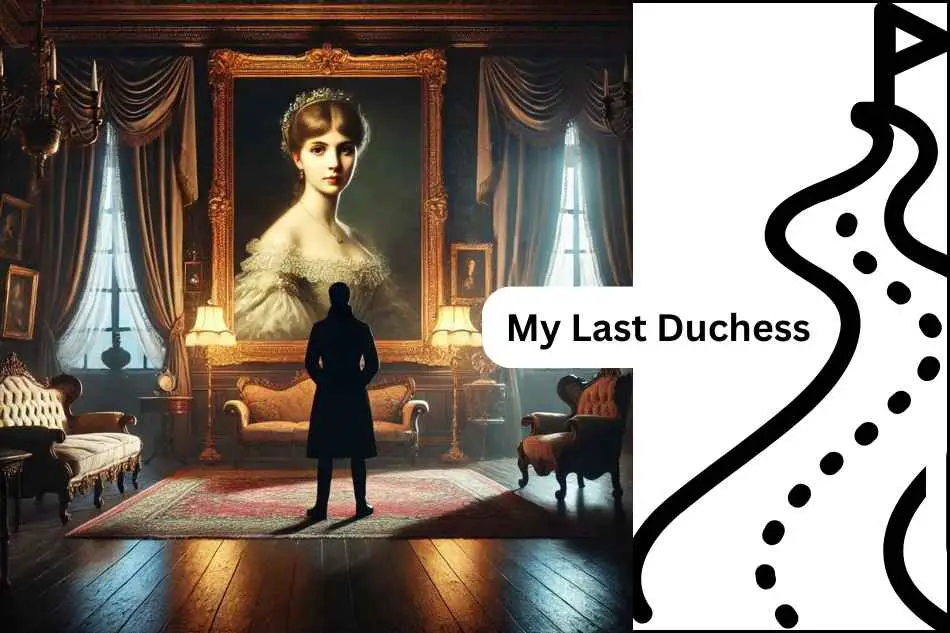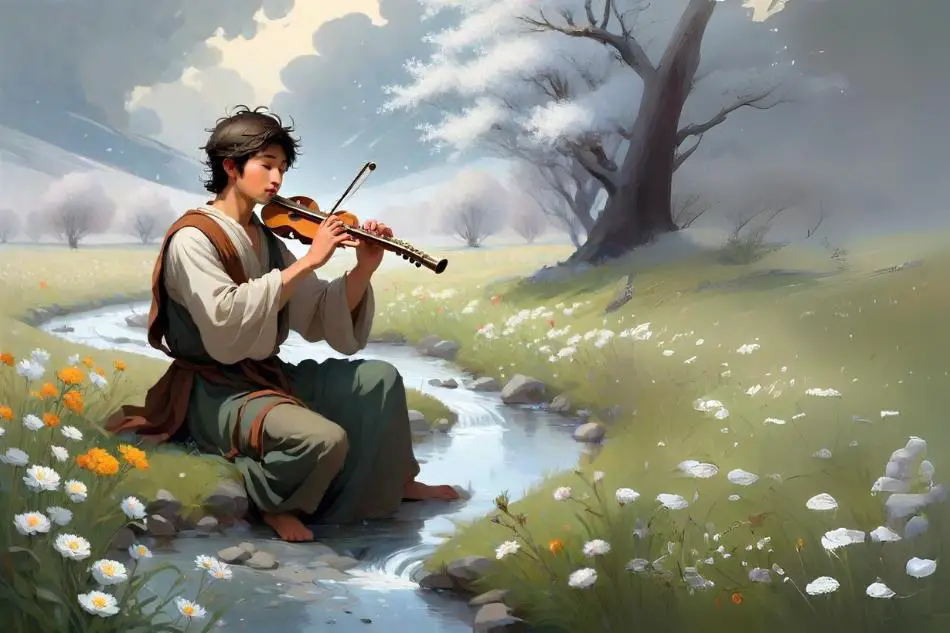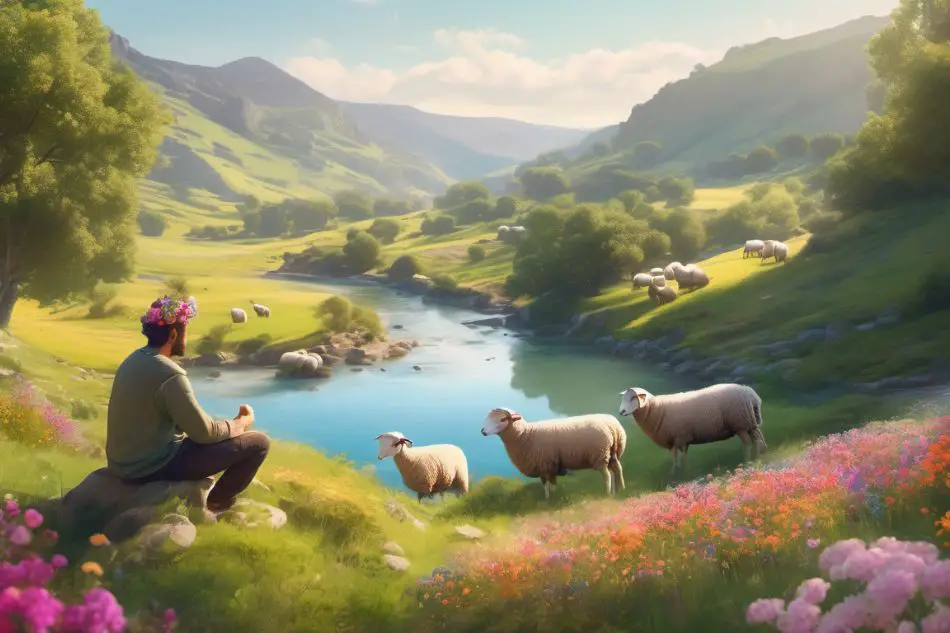“My Last Duchess” by Robert Browning is a dramatic monologue that reveals the disturbing mindset of an arrogant and controlling duke. The poem offers a critical examination of power, possession, and jealousy within a Renaissance setting.
As the Duke speaks to an emissary about his deceased wife, the audience gains insight into his possessive nature and cruel manipulations. The use of subtle language and clever imagery captivates readers, provoking them to analyze the Duke’s character and his distorted perception of love and marriage.
This complex and multi-layered poem invites critical appreciation by delving into the themes of male dominance, objectification of women, and the abuse of authority. Through Browning’s masterful use of language and psychological insight, the poem offers a thought-provoking exploration of human nature and societal constructs.
Table of Contents
Understanding Robert Browning’s Intention
Understanding Robert Browning’s Intention in “My Last Duchess” is essential to unraveling the poem’s depth and complexity. Browning’s artistic prowess and carefully constructed narrative reveal a multitude of layers that invite critical appreciation and analysis.
Unveiling The Complexity Of “my Last Duchess”
Browning’s “My Last Duchess” presents a multi-dimensional exploration of power, control, and the intricacies of human emotion.
The poem is a dramatic monologue that provides insight into the mind of the Duke as he speaks of his late Duchess.
Understanding the nuances embedded within the lines requires a keen eye for detail and an appreciation for Browning’s masterful storytelling.
Delving Into Browning’s Artistic Expression
Browning’s intentional use of language, imagery, and symbolism adds layers of meaning to “My Last Duchess.”
The careful selection of words and the intricately woven narrative invite readers to delve deep into the psyche of the characters and the underlying themes of dominance, jealousy, and the objectification of women.
Browning’s artistry is evident in his ability to skillfully convey complex emotions and motivations through the Duke’s compelling monologue.
Historical And Literary Context Of The Poem
The historical and literary context of Robert Browning’s “My Last Duchess” provides valuable insight into the poem’s significance and influences. Analyzing the Victorian era influence and understanding Browning’s narrative style are essential for a critical appreciation of the poem.
Analyzing The Victorian Era Influence
The Victorian era was characterized by strict social norms, patriarchal values, and an emphasis on outward appearances. This context is crucial for interpreting “My Last Duchess,” as it reflects the societal expectations and power dynamics of the time.
Browning’s portrayal of the Duke’s possessiveness and control over his late wife aligns with the Victorian notion of male dominance, shedding light on the darker aspects of the era’s social structure.
Significance Of Browning’s Narrative Style
Browning’s narrative style in “My Last Duchess” is marked by dramatic monologue, a technique he skillfully employs to give the Duke a platform to express his thoughts and feelings.
The first-person narrative allows readers to delve into the psyche of the Duke, revealing his arrogance, callousness, and sense of entitlement.
This distinctive approach enhances the poem’s impact, offering a compelling exploration of the character’s complex nature and making the narrative more engaging for the audience.
Theme Exploration
Upon critically appreciating the poem “My Last Duchess” by Robert Browning, delving into its themes is essential to understand the deeper significance of the work.
In this exploration, we will uncover the power dynamics in the Duke’s monologue and the portrayal of jealousy and control that shape the poem’s intriguing themes.
Let’s analyze how these themes play a pivotal role in the narrative and contribute to the overall depth of Browning’s masterpiece.
Power Dynamics In The Duke’s Monologue
The theme of power dynamics is prevalent throughout “My Last Duchess,” as the Duke uses his monologue to assert his dominance and control.
The Duke’s authoritative tone and language exemplify his desire to hold power over not only the painting of the Duchess but also her memory. This theme is heightened as the Duke consistently references the Duchess as “my last Duchess,” emphasizing his possessiveness and control over her, even in death.
The Portrayal Of Jealousy And Control
Central to the poem is the portrayal of jealousy and control, showcasing the Duke’s insecurity and possessiveness. His manipulation of the painting reflects his attempts to suppress the Duchess’s free-spirited nature, indicative of his jealousy and need for control.
This theme sheds light on the toxic nature of the Duke’s character and his inability to handle the Duchess’s perceived flirtations with others.
Character Analysis
Character analysis is a crucial aspect of literary appreciation, providing insight into the complex personalities within a work of art. In Robert Browning’s “My Last Duchess,” delving into the characters’ traits and motivations enhances our understanding of the poem’s thematic depth.
This character analysis explores the captivating personas of the Duke and the Duchess, unraveling their intricacies and shedding light on their impact within the narrative.
Unraveling The Persona Of The Duke
The Duke in “My Last Duchess” is a compelling yet enigmatic figure, whose character is revealed through his words and actions. Arrogant and possessive, the Duke exudes a sense of entitlement and control, evident in his disdain for the Duchess’s innocent nature.
His manipulative nature is unveiled as he proudly displays the portrait, using it as a tool to exert power and assert his dominance. Furthermore, his egotistical disposition is highlighted as he takes credit for the Duchess’s beauty, focusing solely on her as an object to be possessed rather than a person with her own autonomy.
Deciphering The Mysterious Duchess
The Duchess, albeit depicted through the lens of the Duke’s biased narrative, emerges as a vibrant, innocent, and free-spirited individual. Her graceful and charming nature is showcased through the Duke’s recounting of her interactions with others, emphasizing her ability to find joy in the simplest of pleasures.
However, her perceived independence and carefree demeanor clash with the Duke’s desire for complete control, ultimately leading to her tragic demise. Despite her absence in the poem, the Duchess’s character leaves a lasting impression, evoking empathy and curiosity within the reader.
Narrative Techniques And Literary Devices
Delve into the critical appreciation of “My Last Duchess” by Robert Browning, exploring the narrative techniques and literary devices employed.
Uncover the profound use of dramatic monologue, symbolism, and irony to convey themes of power, art, and control. Witness how Browning’s masterful storytelling captivates and challenges readers’ perspectives.
Interplay Of Tone And Language
The narrative technique employed by Browning in “My Last Duchess” is characterized by the interplay of tone and language. The poem is presented as a dramatic monologue, a form that allows the Duke to reveal his thoughts and emotions indirectly, capturing his internal conflict and complex personality.
The tone shifts between charming and sinister, as the Duke alternates between describing the Duchess’s portrait with admiration and expressing his jealousy and possessiveness. This strategic use of tone and language creates a compelling narrative that unravels the Duke’s true intentions and moral ambiguity.
Symbolism And Imagery In Browning’s Poetry
Browning employs rich symbolism and vivid imagery in “My Last Duchess” to convey deeper meanings and evoke emotional responses from the readers.
The Duke’s manipulation of the portrait symbolizes his desire for control and power, while the mention of the bronze statue of Neptune taming a sea-horse serves as a metaphor for the Duke’s dominance over the Duchess.
The use of imagery, such as the description of the abundance of cherries, hints at the sensuality and vitality that the Duchess possessed, contrasting with the Duke’s repressive nature.
Through these literary devices, Browning effectively conveys the themes of male ego, dominance, and the objectification of women in society.
Critical Reception
Robert Browning’s “My Last Duchess” has sparked diverse scholarly perspectives and evoked fascinating evolution of interpretations over time.
Evolution Of Interpretations Over Time
The critical reception of “My Last Duchess” has witnessed a remarkable evolution of interpretations over time. Initially, the poem was viewed as a dramatic monologue portraying the character of the Duke and his narcissistic nature.
However, with the passage of time, scholars dug deeper into the subtext, uncovering layers of complexity and psychological depth within the poem.
This evolution has led to a more nuanced understanding of the Duke’s character and the power dynamics portrayed in the poem.
Diverse Scholarly Perspectives
The poem has garnered a wide array of diverse scholarly perspectives, each offering unique insights and interpretations. Some critics focus on the themes of power, control, and misogyny, delving into the social and historical context in which the poem was written.
Others analyze the intricate use of language and poetic devices, shedding light on the nuances of Browning’s craft. Additionally, feminist scholars have examined the portrayal of women and gender dynamics within the poem, sparking thought-provoking discussions about societal norms and attitudes towards women during the Victorian era.
Societal And Gender Implications
The poem “My Last Duchess” by Robert Browning raises complex societal and gender implications that have sparked considerable interest and debate.
This analysis delves into the societal constructs and gender dynamics portrayed in the poem, focusing on the examination of patriarchy and privilege and the controversies surrounding feminist readings.
Examination Of Patriarchy And Privilege
One of the central themes in “My Last Duchess” is the examination of patriarchy and privilege. The Duke’s possessive and controlling attitude towards his deceased wife reflects the patriarchal norms of the time, where women were often seen as possessions or objects of control for men.
This portrayal prompts a critical evaluation of the power dynamics within the societal structure of the poem.
Controversies Surrounding Feminist Readings
Feminist readings of “My Last Duchess” have sparked controversies and diverse interpretations. Some critics argue that the poem perpetuates a misogynistic narrative, highlighting the suppression of the Duchess’s agency and autonomy by the dominant male figure.
Conversely, others contend that the poem offers a critique of the societal oppression faced by women, shedding light on the limitations imposed upon them by patriarchal systems.
Comparisons And Influences
When it comes to critically appreciating “My Last Duchess” by Robert Browning, it is crucial to examine its comparisons with contemporary works and its influence on modern literature.
Understanding the way Browning’s writing differs from his peers and how his work has left a lasting impact on subsequent literature can provide valuable insights into the significance and relevance of this iconic poem.
Contrasting Browning’s Works With His Contemporaries
Browning’s poetic style and themes often diverged from those of his contemporaries, such as Tennyson and Wordsworth. While Wordsworth and Tennyson often emphasized nature and reflection on the self, Browning delved into the complexities of human psychology and the darker aspects of human nature.
His use of dramatic monologue as a narrative technique also set him apart, allowing him to explore the depths of his characters’ minds in a uniquely compelling manner.
Influence Of “my Last Duchess” On Modern Literature
The impact of “My Last Duchess” can be seen in modern literature through its exploration of power dynamics, jealousy, and control.
Modern authors have been inspired by Browning’s ability to create a multi-layered narrative through the voice of a single character, influencing the development of unreliable narrators and psychological explorations in literature.
Relevance And Impact
Resonance With Contemporary Audiences
Robert Browning’s “My Last Duchess” continues to captivate contemporary audiences with its exploration of power, jealousy, and control. The themes resonate strongly in today’s society, where discussions surrounding toxic masculinity and gender power dynamics are prevalent.
The poem offers a critical lens through which modern readers can analyze the consequences of unchecked power and the objectification of women, making it highly relevant in the current social and political landscape.
The Lasting Legacy Of Browning’s Magnum Opus
Browning’s “My Last Duchess” has left an indelible mark on the literary world, serving as a timeless example of dramatic monologue and psychological insight. Its impact persists through the ages, influencing subsequent poets, writers, and scholars.
The poem’s exploration of human nature and the complexities of relationships continues to be studied and appreciated, solidifying its status as a hallmark of 19th-century literature.
Conclusion
In “My Last Duchess,” Browning’s poetic prowess shines through as he delves into the complexities of human nature and the power dynamics within relationships.
The poem’s compelling narrative and rich imagery captivate readers, making it a timeless classic.
With its depth and emotional resonance, “My Last Duchess” continues to intrigue and inspire literary enthusiasts.
FAQs on Critical Appreciation Of “My Last Duchess” By Robert Browning
Question 1: What Is The Critical Appreciation Of The Poem My Last Duchess?
Answer: The critical appreciation of the poem “My Last Duchess” highlights the Duke’s possessiveness and control over his deceased wife. The poem’s structure and language reflect the Duke’s arrogance and moral deficiency, inviting analysis of his character and the theme of power dynamics in relationships.
Question 2: What Is The Main Message Of The Poem My Last Duchess?
Answer: The main message of the poem “My Last Duchess” is about the possessiveness and controlling nature of the Duke. It reveals the themes of power, jealousy, and the objectification of women. The Duke’s attitude towards his late wife reflects a sense of entitlement and dominance.
Question 3: What Is The Critical Appreciation Of Browning’s The Last Ride Together?
Answer: Browning’s The Last Ride Together is a poem that explores themes of love, freedom, and acceptance. It illustrates the speaker’s emotions and experiences during a romantic horseback ride with his beloved. The poem captures the beauty and complexities of love and human nature.
Question 4: What Is Critical Appreciation In Literature?
Answer: Critical appreciation in literature is the analysis and evaluation of a literary work’s content, style, and themes. It involves examining the text’s strengths and weaknesses. By delving into its significance, critics assess its impact on readers and its contribution to the literary canon.
Question 5: What Is The Main Theme Of “My Last Duchess”?
Answer: The main theme of the poem is power, control, and jealousy in a relationship.








You must be logged in to post a comment.